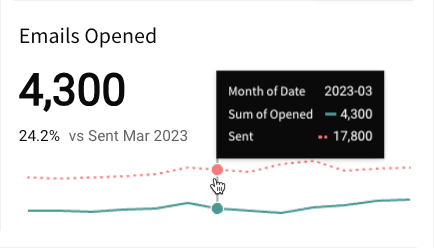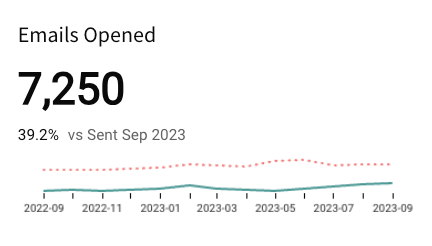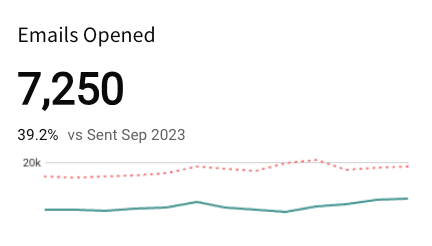Build a KPI chart
Sigma's KPI chart element has replaced the Single Value visualization (SVV) option. For information about the SVV deprecation and benefits of KPI charts, see the Sigma Community post.
Key performance indicator (KPI) charts highlight single metric values typically used to measure performance or progress toward goals. Create a KPI chart to summarize the total value of a metric for a specific period, or include additional data to compare the metric’s value over time and measure it against a benchmark or target value.

Example use cases:
Marketing analytics: Track click-through rates to highlight email campaign performance over time.
Executive dashboarding: Measure monthly year-over-year revenue to understand how the current month’s revenue compares to the previous year benchmark.
Manufacturing analytics: Report cycle time to analyze the amount of time it takes a product to complete the manufacturing process.
User requirements
The ability to create KPI charts and other charts requires the following:
-
You must be assigned an account type with the Edit Workbook and/or Explore Workbook permission enabled.
-
You must be the workbook owner or be granted Can explore or Can edit workbook permission.
If you’re granted Can explore access to the workbook, you can create and modify chart properties and formatting in Explore mode, but you cannot publish your changes.
KPI chart variations
Sigma’s KPI charts allow you to track and display metrics in various ways depending on how you configure the element properties.
Static variations
 | Summary valueSummarize the metric's global value to understand overall performance or magnitude. The KPI chart highlights the global summary, which aggregates the metric values across the entire dataset. Required element properties: |
 | Benchmark summary comparisonSummarize a metric's global value against a benchmark or target value. Assess relative performance and gain insight into patterns, relationships, and correlations. The KPI chart highlights the global summary, which aggregates the metric values across the entire dataset. It also displays a comparison as a percentage, delta, or absolute value. Required element properties:
|
Time series variations
 | Period valueMeasure a metric's period value to analyze performance during a specific time interval (like week, month, or year). The KPI chart highlights the latest period value or global summary, and it can display a trend line that illustrates patterns and changes across sequential time periods. Required element properties: |
 | Period comparisonMeasure a metric’s value in one period (like week, month, or year) against another to perform a sequential or period-over-period comparison. The KPI chart highlights the latest period value or global summary, and it can display the comparison as a percentage, delta, or absolute value. It can also include a trend line that illustrates patterns and changes over time. Required element properties:
|
 | Benchmark period comparisonCompare a metric's period value against a benchmark or target to assess relative performance and gain insight into patterns, relationships, and correlations. The KPI chart highlights the latest period value or global summary, and it can display a comparison as a percentage, delta, or absolute value. It can also include a trend line for both values to illustrate patterns and changes over time. Required element properties:
|
When loading or refreshing a workbook, Sigma typically sends a separate query for each data element. If the workbook contains multiple static KPI charts (summary value and benchmark summary comparison variations) that share a data source, Sigma employs query batching. This consolidates the data requests from all applicable KPI charts into a single query to reduce query processing overhead and optimize performance. Time series KPI charts (period value, period comparison, and benchmark period comparison variations) send separate queries to the database and aren't included in query batching.
Basic KPI chart configurations
Build a basic KPI chart by configuring the following element properties:
| Chart | Chart type displayed in the workbook |
| Value | Calculation that determines the metric value |
| Timeline | Date data that defines the reporting period |
| Comparison | Period or calculation that defines the comparison value |
At the core of every chart element is its underlying data, which supplies the information the chart visualizes. As you build a KPI chart, Sigma automatically calculates and structures your data to associate element properties with columns ("source columns") in the underlying data table.When you configure a property by aggregating an existing column, adding a custom formula or value, or applying the row count, Sigma creates a new source column.
For information about how to view the underlying data while you configure the chart, see Maximize or minimize a data element.
Add a KPI chart element
Add a chart element and designate it as a KPI chart.
You can also create a new KPI chart directly from a summary value in a table element. Right-click the table summary to open the menu, then select Create KPI element.
-
Open a workbook in Explore or Edit mode and add a new chart element.
-
In the Chart property, click the dropdown field and select KPI from the list.

Calculate the metric
Configure the Value property to calculate the metric. This configuration is required to build any KPI chart variation.
-
In the Value property, click
Add calculation, then use one of the following methods to calculate the metric:
-
To aggregate the values of an existing column, search or scroll the Aggregate column list and select the preferred column.
-
To add a custom calculation or value, select Add new column, then enter the calculation or value in the formula bar.
-
To count the number of rows in the underlying dataset, select Row count.
You can also aggregate the values of an existing column by dragging and dropping a column name from the Columns list to the Value property.
When the Timeline property is not configured, the chart displays the metric's global summary value, which aggregates all data points in the resulting Value property source column. If you deselect the Aggregate values checkbox, one value from the column is selected and displayed instead of a global summary. For information about the value displayed after configuring the Timeline property, see Define the reporting period in this document.
![KPI showing the global summary of a sum of profit column with no timeline configured. The aggregate values checkbox is checked, and the column uses the Sum([Profit]) formula.](https://sigma-docs-screenshots.s3.us-west-2.amazonaws.com/Workbooks/Visualizations/Build+a+KPI+Chart/kpi_define-metric-value_step-1b.png)
When you add a metric, the values are automatically aggregated and the Aggregate values checkbox is selected.
-
-
[optional] If you want to control how the metric is measured and formatted, leave the Aggregate values checkbox selected and adjust the aggregate, data type, or format of the metric value using the column menu or formula toolbar:
-
In the Value property, hover over the column name, then click the caret (
) to open the column menu.
-
Hover over any of the following items and select the preferred option:
Set aggregate Measure the metric based on the selected aggregation method. Transform Convert the column to the selected data value type. Format Display the metric value in the selected format.
For example, you can format a sum of profit KPI to display using SI units:


-
Define the reporting period
Configure the Timeline property to define the reporting period for the time series. This configuration is required to build a period value, period comparison, or benchmark period comparison KPI chart.
-
In the Timeline property, click
Add column, then use one of the following methods to define the reporting period:
-
To derive the period from an existing date column, search or scroll the Select column list and select the preferred column.
-
To create a period based on a new date column, select Add new column, then enter a date function or value in the formula bar.
The Timeline property supports date columns only. You cannot select or create a column that does not contain date data.
When a source column is added to the Timeline property, two changes occur in the chart:
-
The chart now displays the metric's latest period value, which aggregates the Value property source column data for the most recent period. To change the default display value to the global summary, proceed to the next step.
-
If the element layout size allows, the chart displays a trend line, which you can hover over to view previous period values. For information about how to hide the trend line, see Customize the trend line in this document.

-
-
[optional] Change the default display type (the value displayed when not interacting with the trend line):
-
In the Value property, hover over the source column name, then click the caret (
) to open the column menu.
-
Hover over Default display type and select an option:
Latest period Display the aggregate value for the most recent period in the time series. Global summary Display the aggregate value for all periods in the time series.

-
-
[optional] Control how the period is measured and formatted:
-
In the Timeline property, hover over the column name, then click the caret (
) to open the column menu.
-
Hover over any of the following items and select the preferred option:
Truncate date Measure the metric value based on the selected period. Format Display the period date in the selected format.

-
Select a comparison period
Configure the Comparison > Period property to measure a sequential or period-over-period comparison for the metric. This configuration is required to build a period comparison KPI chart.
When the benchmark or target value is null (for example, the first week in a sequential week-over-week analysis), the comparison value and label are hidden.
-
In the Comparison property, enable the Period option. If a source column is configured in the Timeline property, the option is automatically enabled.
-
Open the dropdown and select a type of period comparison.
Configuring a column in the Timeline property automatically engages the Comparison property. To build a KPI chart that highlights the period value of a metric without displaying a comparison, ensure the dropdown is set to None.

By default, a comparison value displays as a percentage. To instead display a delta or absolute value, customize the comparison in the Element format panel.

Select a comparison value
Configure the Comparison > Column property to measure the metric against a benchmark or target value. This configuration is required to build a benchmark summary comparison or benchmark period comparison KPI chart.
-
In the Comparison property, click
Add calculation, then use one of the following methods to calculate the benchmark or target value:
-
To aggregate values in an existing column, search or scroll the Aggregate column list and select the preferred column.
-
To add a custom calculation or value, select Add new column, then enter the calculation or value in the formula bar.
-
To count the number of rows in the underlying dataset, select Row count.

By default, a comparison value displays as a percentage. To instead display a delta or absolute value, customize the comparison in the
Element format panel.

-
-
[optional] Control how the benchmark or goal is measured and formatted:
-
In the Comparison property, hover over the column name, then click the caret (
) to open the column menu.
-
Hover over any of the following items and select the preferred option:
Set aggregate Measure the metric based on the selected aggregation method. Transform Convert the column to the selected data value type.

-
Advanced KPI chart properties and formatting
Sigma features various properties and format options that give you the flexibility to build detailed KPI charts.
The following sections introduce configurations that can enhance your charts and help you deliver specific insights with meaningful and actionable information.
Change the value color
Change the metric value’s font color in the Element properties > Marks > Color tab. This determines the default color of the metric value, which can be overridden by conditional formatting rules.
The Color property (including conditional formatting) applies to the metric value only and doesn’t affect the element title or comparison font.
 |  |
Add conditional formatting
Configure formatting rules rules (click + Add rule) in the Element properties > Marks > Color tab to change the metric value’s font color according to value-based conditions. This allows you to highlight or emphasize the value when it meets the specified conditions.
 |  |
Customize the value font
Customize the metric value’s font weight, color, and size in the Element format > Value section.
The Value format settings apply to the metric value only and don’t affect the element title or comparison font. If you change the font color in this section, the font color is also changed in the element’s Color property.

Customize the comparison display
Customize the comparison display in the Element format > Comparison section.

In addition to modifying the color indicators, you can change the font size of the comparison value, show or hide the label, and customize the label content.
You can also select the type of comparison displayed and identify the favorable direction of the comparison. The Direction setting determines when the Good color, Neutral color, and Bad color indicators apply to the comparison value.
| Display | ||
|---|---|---|
| % difference from | Display the percent of increase or decrease relative to the comparison value. |  |
| Difference from | Display the numerical increase or decrease relative to the comparison value. |  |
| % of | Display the percent of the comparison value. |  |
| Absolute | Display the absolute value of the comparison period or column. |  |
| Direction | ||
|---|---|---|
| Higher is better | Apply the Good color selection to increased comparative values and the Bad color selection to decreased comparative values. |  |
| Lower is better | Apply the Good color selection to decreased comparative values and the Bad color selection to increased comparative values. |  |
| None | Apply no color indicator to the comparative value. |  |
Customize the trend line
Customize the trend line in the Element format > Trend section.

In addition to showing and hiding the trend line, you can select the trend line shape (line or area) and customize its colors.
| Shape | |
|---|---|
| Line | Area |
 |  |
You can also enable tooltips on hover, display the x-axis with timeline tick marks and labels, and display the y-axis with grid lines and labels.
| Display options | ||
|---|---|---|
| Show tooltip | Show timeline axis | Show y-axis |
 |  |  |
Customize the chart layout
Customize the chart layout in the Element format > Layout section.

Change the alignment of the text components, and select the location of the title and comparison value.
| Alignment | ||
|---|---|---|
| Left | Center | Right |
 |  |  |
| Title | |
|---|---|
| Top | Bottom |
 |  |
| Comparison value | |
|---|---|
| Right | Below |
 |  |
All KPI chart format options
Updated 2 months ago
